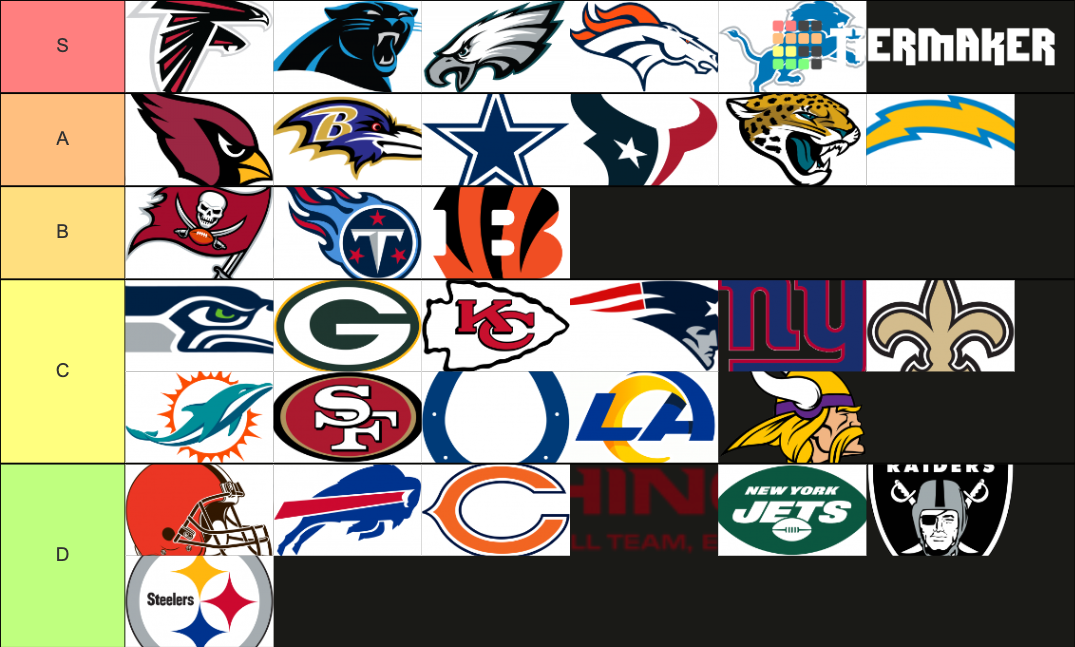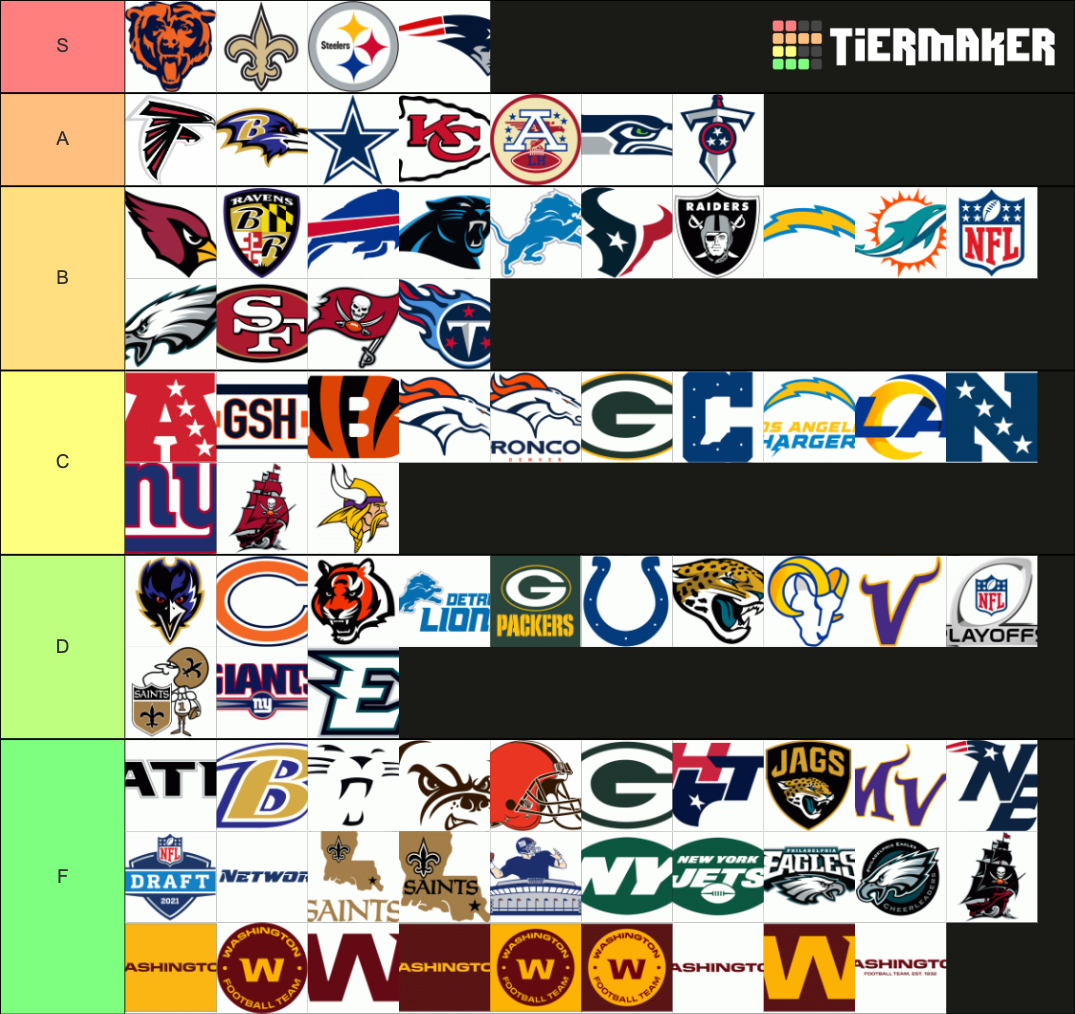Welcome to the world of NFL tier lists, where strategy meets passion! Whether you're a seasoned fantasy football guru or just starting your journey into the NFL universe, understanding tier lists is crucial. These lists help you make informed decisions when drafting players, evaluating team strengths, and staying ahead of the competition. But let's not get ahead of ourselves—before we dive deep into the intricacies of NFL tier lists, let’s set the stage with some background info that’ll keep you hooked.
So, what exactly are NFL tier lists? Simply put, they're rankings of players grouped by their value and potential. Instead of just listing players in order, tiers categorize them into groups based on performance expectations, consistency, and overall impact. This approach gives you a clearer picture of who’s worth drafting early and who might be a sleeper pick later on.
Now, imagine this: you're sitting at your fantasy draft table (or virtual room), surrounded by stats, rankings, and endless possibilities. Suddenly, someone asks, "Who should I take in Round 3?" Without a proper tier list, you'd be scrambling to make a decision. But with one? You'd be confident, cool, and ready to crush it. And that, my friends, is why we’re here today.
Read also:Isis Serrath And Guty Carrera A Tale Of Love Fame And Celebrity
What Are NFL Tier Lists and Why Do They Matter?
Let's break it down, shall we? NFL tier lists aren’t just random rankings—they’re strategic tools designed to help you dominate in fantasy football and beyond. Here's how they work:
- Tiers group players into categories based on their projected performance.
- They provide a visual hierarchy that makes it easier to compare players across positions.
- By using tiers, you avoid overvaluing or undervaluing players during drafts.
For example, if you're deciding between two running backs, one might be ranked higher overall, but they could be in the same tier. This means they're equally valuable, so you can focus on other factors like team needs or matchups.
How NFL Tier Lists Impact Your Draft Strategy
Ever heard the phrase "draft with confidence"? That's exactly what tier lists bring to the table. Here's why:
- They help you identify undervalued players who might outperform their draft position.
- Tiers allow you to pivot quickly if someone unexpected gets snatched up early.
- They keep you focused on value rather than name recognition alone.
Let’s say you’re eyeing a star quarterback, but they get taken right before your turn. With a tier list, you can immediately shift to another high-value player without panicking. It’s like having a cheat sheet that keeps you two steps ahead.
Creating Your Own NFL Tier List
Think you're ready to create your own tier list? Great! Here's a step-by-step guide to get you started:
First off, gather your data. Look at last season's stats, preseason performances, and expert projections. Pay attention to things like:
Read also:Does Joe Santagato Have A Girlfriend Unveiling The Truth Behind The Spotlight
- Touchdowns and yards per game.
- Injury history and current health status.
- Schedule difficulty and favorable matchups.
Once you've collected all the info, start grouping players into tiers. For instance:
- Tier 1: Elite players who dominate consistently.
- Tier 2: Solid contributors who have occasional standout games.
- Tier 3: Riskier picks with high upside but inconsistent performance.
Remember, your tier list doesn't have to match everyone else's. Customize it based on your league rules, personal preferences, and risk tolerance. After all, this is YOUR strategy!
Key Factors to Consider When Building Tier Lists
Not all players are created equal, and that's where tier lists shine. Here are some key factors to keep in mind:
- Positional scarcity: Certain positions, like tight ends, often have fewer elite options. Factor this into your tiers.
- Team dynamics: A player's role within their offense can drastically affect their value.
- Injury concerns: Even the best players aren’t worth much if they’re sidelined for half the season.
By weighing these factors, you'll build a more accurate and effective tier list. And hey, who doesn’t love being the smartest person in the draft room?
The Importance of Updating Your Tier Lists
Here's a harsh truth: football is unpredictable. Injuries happen, rookies breakout, and veteran stars decline faster than you can say "bye-bye." That's why updating your tier lists throughout the season is essential.
Let’s look at some scenarios:
- A star running back suffers a season-ending injury. Suddenly, his backup becomes a must-draft player.
- A rookie quarterback starts lighting it up in Week 4. Do you bench your veteran starter or roll with the hot hand?
- A team switches offensive coordinators midseason. How does that impact your wide receivers?
By keeping your tier lists up-to-date, you'll always have the latest info at your fingertips. Think of it as maintaining a living, breathing strategy guide.
Using Analytics to Enhance Your Tiers
Data nerds rejoice! Analytics can take your tier lists to the next level. Tools like Expected Points Added (EPA) and Fantasy Points Per Touch (FPT) offer deeper insights into player performance. Plus, they help you spot trends that traditional stats might miss.
For example, a running back might not have many touchdowns yet, but if their EPA is sky-high, they're likely due for a breakout. Similarly, a receiver with a low catch rate but high FPT could be primed for a big game.
Of course, don’t rely solely on numbers. Combine analytics with film study and expert analysis for the best results. After all, football is as much art as it is science.
Common Mistakes to Avoid When Making Tier Lists
Even the best analysts make mistakes sometimes. To keep you from falling into common traps, here are a few pitfalls to watch out for:
- Overvaluing name recognition: Just because a player had a great season last year doesn’t mean they’ll repeat it.
- Ignoring team changes: New coaches, schemes, and personnel can drastically alter a player’s role.
- Forgetting about matchups: Some players thrive against weaker defenses but struggle against elite units.
By avoiding these errors, you'll create more accurate and reliable tier lists. And remember, the goal isn’t perfection—it’s improvement.
How to Stay Ahead of the Competition
So, you’ve built your tier list, updated it regularly, and avoided common mistakes. What’s next? It’s time to outsmart the competition. Here’s how:
- Pay attention to waiver wire activity in your league. Undrafted gems can become instant studs.
- Monitor social media and news outlets for breaking updates. Sometimes, the best moves happen off the field.
- Trust your gut—but only if it’s backed by data. Intuition has its place, but it shouldn’t override logic.
Stay proactive, stay informed, and most importantly, stay flexible. The NFL is a game of adjustments, and so is fantasy football.
Expert Tips for Maximizing Tier List Effectiveness
Ready to take your tier lists to the next level? These expert tips will help you dominate:
- Blend tiers across positions: Don’t just rank running backs against running backs—compare them to wide receivers, tight ends, and quarterbacks as well.
- Focus on value over cost: A mid-round pick with high upside might deliver more points than a first-rounder who underperforms.
- Be willing to adapt: If your initial strategy isn’t working, don’t be afraid to pivot. Flexibility is key in fantasy football.
These strategies will give you an edge in both drafts and trades. And when it comes to winning, every little advantage counts.
Real-Life Success Stories Using Tier Lists
Don’t just take my word for it—here are a few real-life examples of how tier lists have helped fantasy football managers succeed:
In 2022, a manager drafted Derrick Henry late due to injury concerns but kept him in Tier 1 because of his immense talent. When Henry returned healthy, he delivered top-tier production and carried the team to victory.
Another manager used tier lists to identify undervalued sleepers like Justin Jefferson and Ja’Marr Chase. Both players became fantasy superstars, proving that smart tiering pays off big time.
These stories show that tier lists aren’t just theoretical—they’re practical tools that deliver real results.
Conclusion: Take Action and Dominate with NFL Tier Lists
We’ve covered a lot of ground, from understanding what tier lists are to mastering the art of creating and updating them. By now, you should feel confident in your ability to dominate fantasy football—and maybe even impress your friends with your newfound expertise.
So, what’s next? Start building your tier lists today! Use the tips and strategies we’ve discussed to craft a plan that works for you. And don’t forget to share your success stories in the comments below—we’d love to hear how tier lists are helping you win.
Until next time, stay sharp, stay informed, and most importantly, have fun out there. The NFL season is waiting—go crush it!
Table of Contents
- What Are NFL Tier Lists and Why Do They Matter?
- Creating Your Own NFL Tier List
- The Importance of Updating Your Tier Lists
- Common Mistakes to Avoid When Making Tier Lists
- Expert Tips for Maximizing Tier List Effectiveness
- Real-Life Success Stories Using Tier Lists
There you have it—a comprehensive guide to NFL tier lists that’s packed with actionable insights and expert advice. Now go out there and show the world what you’re made of!


